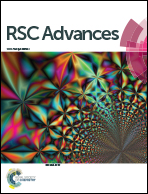A mechanistic study on amphiphilic block co-polymer poly(butadiene-b-(ethylene oxide)) vesicles reveals the water permeation mechanism through a polymeric bilayer†
Abstract
The objective of this work is to study the interdependence between the membrane tension and osmotic permeability of a di-block copolymer PBD-PEO (poly(butadiene-b-(ethylene oxide))) bilayer. Experiments were conducted to decouple the contribution of membrane tension into (1) PEO conformation; (2) area stretching modulus (κa); (3) bending rigidity modulus (κc); (4) chemical crosslinking on the PBD segment. A range of different PBD-PEO block copolymer formulations has been included with similar hydrophilic/lipophilic balance (HLB) factor and end-group for a systematic comparative study. We have also demonstrated the applicability of a membrane probe, laurdan, to study small-to-medium molecular weight PBD-PEO polymersomes and the results are consistent with area stretching and bending rigidity moduli measured otherwise. In addition, we are able to correlate the membrane rigidity with the osmotic permeability, to fortify our conclusion that the solute permeation mechanism through the block copolymer bilayer is dominated by (1) mass transfer at the interfacial region, and (2) diffusion through the hydrophobic segment. By subjecting the block polymer to chemical crosslinking in the PBD segment, the polymer was engineered to be much more rigid and much less permeable to osmotic flux.


 Please wait while we load your content...
Please wait while we load your content...